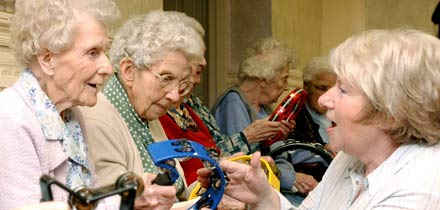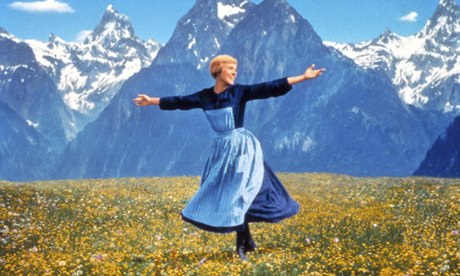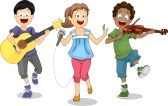Songs and music
for special needs situations
Songs and music lists - Home page here with updates
Prelim notes here. About an initial visit here
Although carers have their own set of pages here, there's no reason for them not using this series. Some of them will have carees who come into scope.
1 Introduction
- Dementia
- Alzheimer's disease
- Special Educational Needs
- Arts For Healing: Music and Art Therapy
- Music therapy
Although dementia is dealt with, many of the considerations identified apply across other conditions.
This is the Songs and Music Home page
The how and why relating to song and music therapy here
Group 1 - participating audience
Clap your hands here. About an initial visit here.
The how and why are here.
Songs and music for specific audiences here
Songs and music for consideration here
We're the happiest carers in town here
- strum info page here
~~~~~~~~~~~~~~~~~~~~~~~~~~~~~~~~~~~~~~~~
Songs and music lists - Home page here with updates
Ulverscroft Song Books - find a song here
Hootenanny Song Book here
Songs - lyrics & chords - page 1 here
A song key.
Bobby McGee.here
Song quizzes here
The Squiffle Group song here
A Squiffle double bass design here
George Formby here
Many other songs can be offered including
Group 2
Those within this group would be unable to sing or clap here. Perhaps 90% could handle a tambourine or similar such as jingles.
Perhaps 30% could beat a drum. Perhaps 5% of that 30% would be in time with the music. Perhaps beat is the wrong word for many. It implies regularity even if different from the beat/rhythm of the song or music. Hitting the drum (also tambourine) could vary. Some might hit it more or less normally while others might demolish it if frail. Then there is tapping. Some might tap it more or less normally while others might scarcely touch whatever is in their hand.
Adult impairment here
Songs and music for adults with special needs - little participation here
Songs and music - Instruments here Not all for this group.
Group 3 - associated pages elsewhere
Not part of this series of pages but carer songs are here
Main dementia page here
Remember Me - the Hereford Courtyard Theatre 2014 Dementia Week event here
1.1 We begin the page with dementia
As populations of developed nations age, so the number of cases of dementia increases. As a way of helping care for and support people with dementia, music has been shown to often have a dramatic effect.
Whether it’s 60s soul, operatic arias or songs from the shows, music can soothe, stimulate and bring to mind long-forgotten memories. The power of music, especially singing, to unlock memories and kick start the grey matter is an increasingly key feature of dementia care. It seems to reach parts of the damaged brain in ways other forms of communication cannot. reach.


1.2 Alzheimer's disease
Belting out classic numbers from hit musicals can boost the brain function of people with Alzheimer's disease, according to researchers who worked with elderly residents at a US care home.
Over a four-month study, the mental performance of patients who took part in regular group singing sessions improved compared with others who just listened.
In the sessions, patients were led through familiar songs from The Sound of Music, Oklahoma, The Wizard of Oz and Pinocchio.
The sessions appeared to have the most striking effect on people with moderate to severe dementia, with patients scoring higher on cognitive and drawing tests, and also on a satisfaction-with-life questionnaire at the end of the study.
1.3 Moving on to Special Educational Needs, we learn:
A child strums her fingers against a harp. Another dances with glee to the rhythms of a jazz trio. Others listen to a flute melody with their eyes shut.
All are memorable ways in which children and young people engage during Live Music Now (LMN) music sessions.

The graphic is not from LMN.
It's important that all children have access to high quality musical experiences. Not only is it an enjoyable experience, but taking part in regular music-making has been proven to make a major contribution to children's learning, social and personal development in areas including
- Exploring and expressing feelings non-verbally, developing conversational skills.
- Improving mood; developing life skills such as turn-taking, collaborating, teamwork; increasing social interaction and self-confidence
- .
- Improving concentration, memory and developing creativity.
- Encouraging intentional movement, developing motor skills.
- Here is an Amercan video the theme of which can be extended to older children and to participants in future sessions adapting the lyrics of certain songs to fit their situation. Song sheets can be included which utilise the art aspects of what you see here
- Don't forget dance
- The need for the arts is a defining human characteristic. They endure because they have a unique power to help us to feel and make sense of experience. However, where there is psychological vulnerability this power cannot be said to be innately helpful.
- The arts therapies professions have spent over sixty years developing practice, theory and research to understand therapeutic potential of the arts in the care environment.They also have extensive experience in managing potential risks and developing safe practice with their clients.
- The arts therapies group is made up of the four separate professions of Art, Dance-Movement, Drama, and Music therapies.
- flyer from here The appropriate dance specialist and I would combine to produce a session.
- An exploration into combining mental health music thereapy and art therapy has potential here.
- Music therapy might be especially suitable for clients in mental health care who have difficulties engaging in verbal treatment.
- Relational abilities in clients presenting with a low therapy motivation tend to improve when focusing on reproducing music.
- Music listening alone might be contra-indicated when working with low motivated clients in mental health care as it does not seem to support relational abilities.
pagetop here for pasting Songs and music for special needs situations here.